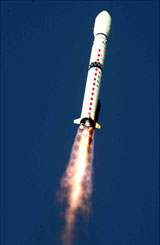Agri market outlook and sector updates: Nirmal Bang
 Johannesburg - The launch of South Africa's and southern Africa's first government-owned satellite from the central Asian republic of Kazakhstan was delayed by a day because of a technical error, the government in Pretoria said Tuesday.
Johannesburg - The launch of South Africa's and southern Africa's first government-owned satellite from the central Asian republic of Kazakhstan was delayed by a day because of a technical error, the government in Pretoria said Tuesday.
A Russian Soyuz rocket had been scheduled to blast off at 20:55:07 Tuesday from the Baikonur cosmodrome in Kazakhstan with both South Africa's 26-million-rand (3.5 million dollar) SumbandilaSat and Russian weather satellite Meteor.
In a statement, the ministry of science and technology said the launch been postponed by 24 hours.
The 81-kilogram satellite, which will orbit 500 kilometres above the Equator and pass over South Africa four times a day, will collect images for use by government in agriculture, water management, urban planning and other domains.
Commissioned by the science department from a company in the Western Cape, SumbandilaSat, which means "to lead the way" in Venda, a South African language, was originally supposed to be launched in 2006 from a Russian rocket over the Barents Sea.
But "geopolitical issues" torpedoed that launch, according to Khalid Manjoo, team leader for assembly, integration and testing at SunSpace & Information Systems, the company that built the satellite.
The United States was concerned about a Russian rocket being launched into orbit over its territory and Russia had to cancel the launch.
The project lay dormant until mid-2008 when South Africa and Russia entered a new agreement on space cooperation, which sees Russia launch the satellite pro bono.
Russia is also cooperating with South Africa on the establishment of South Africa's own space agency, which is expected to be launched by the end of the year.
This is the first government satellite in southern Africa. Elsewhere in Africa, Egypt and Nigeria have also launched satellites. South Africa's first satellite, SunSat, was launched in 1999 as an experiment by the University of Stellenbosch. Its lifetime in space came to an end two years later.
While SumbandilaSat will serve South Africa first and foremost, it can also be used to view "any part of southern Africa or the world," Manjoo told the German Press Agency dpa.
South Africa's ultimate aim is the creation of a constellation of satellites for disaster management in Africa, according to Manjoo. "This would be a technology demonstrator," he says.
The satellite's main imager has a ground resolution of 6.25 metres, meaning it can identify any object that is 6.25 metres long. dpa